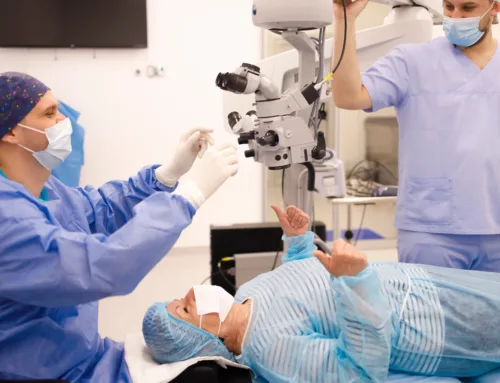The Symfony Lens implant is an advanced technology lens implant that has helped patients around the world achieve glasses-free vision. Its “extended depth of focus” technology gives patients a more continuous range of vision compared to other presbyopia-correcting lens implants.
In this guide, we’re going to tell prospective patients everything you need to know about the Symfony implement. Let’s get started.
What is the Symfony Lens Implant?
The Symfony lens implant is a type of intraocular lens (IOL) that is used in cataract surgery or refractive lens exchange procedures to replace the natural lens of the eye. The Symfony lens is an extended-depth-of-focus IOL that is designed to improve visual acuity and reduce the need for glasses or contact lenses after surgery.
The Symfony lens is a popular choice for patients who want to reduce their dependence on glasses or contact lenses after surgery, as it can provide good vision at a variety of distances. It is also a good option for patients with presbyopia, a condition that causes the natural lens of the eye to become less flexible and less able to focus on objects at close range.
Patients with the Symfony are significantly less likely to need glasses after surgery than patients who get a basic monofocal implant. The table is from the FDA’s clinical trial for Symfony.
How Does the Symfony IOL Work?
During cataract surgery, the natural lens of the eye is removed and replaced with an artificial lens, called an intraocular lens (IOL). The Symfony lens is a type of IOL that is designed to provide a full range of continuous vision, from near to far, without the need for glasses or contact lenses. It is made of a soft, flexible material and is implanted into the eye through a small incision.
How Does The Symfony Differ From Other Advanced Implants?
Traditional multifocal lens implants act like bifocals with two “sweet spots” for your vision. One is set for distance, and the other for near. Patients may notice that the in-between range, or “intermediate range”, may be blurry with these lenses. Intermediate range vision is important for many people. Intermediate range vision can include the computer screen or dashboard in the car.
The Symfony is designed to give a more continuous range of vision without dropping off in the intermediate range.
Are There Patients Who Should Not Get the Symfony IOL?
Like other advanced technology lens implants, there is no one lens implant that is best for everyone. In the Symfony clinical trial there were certain patients who were ruled inelgible to participate.
While these patients may do great with the Symfony, it is important to discuss the risks & benefits with your surgeon if you have one of these conditions. An abbreviated list of some of the more common conditions that may result in not being a good Symfony candidate:
- Corneal abnormalities (including severe dry eyes and irregular astigmatism)
- Pupil abnormalities
- Strabismus or any inability to focus, or fixate for prolonged periods of time
- Capsule or zonule abnormalities
- Glaucoma
- Intraocular inflammation
- Retina disease (e.g. macular degeneration, diabetic retinopathy)
Are There Risks or Side Effects of the Symfony Implant?
Every medical procedure has risks, and most advanced technology lens implants can have side effects in a small percentage of patients.
For the Symfony, glare, halos, and starbursts may be an unwanted side effect. This is common with presbyopia correcting implants.
Glare, Halos, Starbursts
Let’s look at data from the FDA’s clinical trial of the Symfony:
This table compares the Symfony to a standard monofocal lens implant, which does not provide intermediate or near vision without glasses.
You will notice that approximately 5-8% of Symfony patients were “very bothered” by halos, starbursts, or glare symptoms compared to 4-6% in the monofocal lens control group.
In terms of overall satisfaction, patients with the Symfony were more satisfied than the control group when asked if they would want to have their implant removed:
Does the Symfony Implant Fix Astigmatism?
Yes! The Symfony is available in a “toric” version which corrects astigmatism. Your surgeon will take measurements on your eye to determine if the toric version is right for your eyes.
How Much Does the Symfony Cost?
The Symfony implant is not covered by medical insurance. It requires an out-of-pocket payment. This can range from $4,000 to $5,000 per eye on top of the other expenses of the procedure which insurance covers.
Does Medicare Cover the Symfony IOL?
No. Medicare does not cover the Symfony IOL or any other presbyopia-correcting intraocular lens implant.
Medicare will cover the surgeon fee, anesthesia fee, and surgical center’s facility fee. However, the Symfony will require an additional out-of-pocket cost.
The Symfony Lens Review Summary: Is It Right For You?
Overall, the Symfony lens implant is a safe and effective way to improve vision and reduce the need for glasses or contact lenses after cataract surgery or refractive lens exchange. It is important to discuss the potential benefits and risks of the Symfony lens with your eye surgeon to determine if it is the right choice for you.














